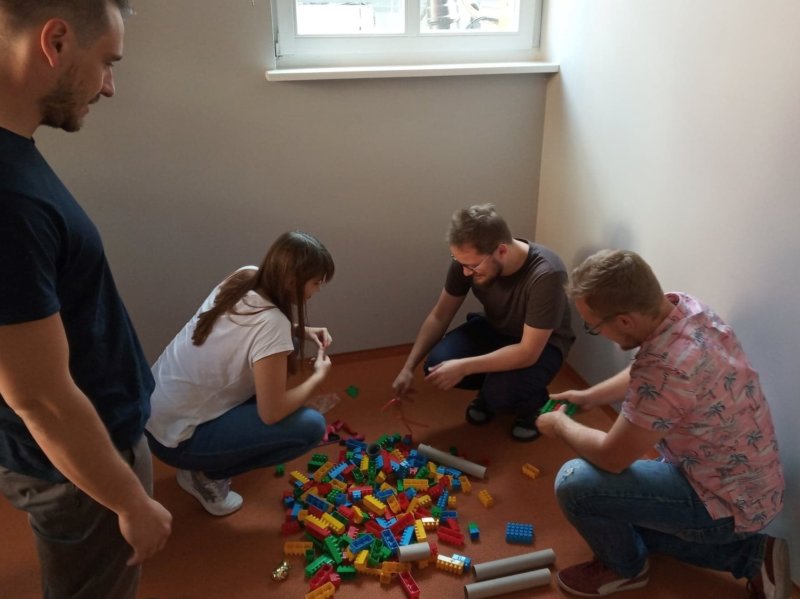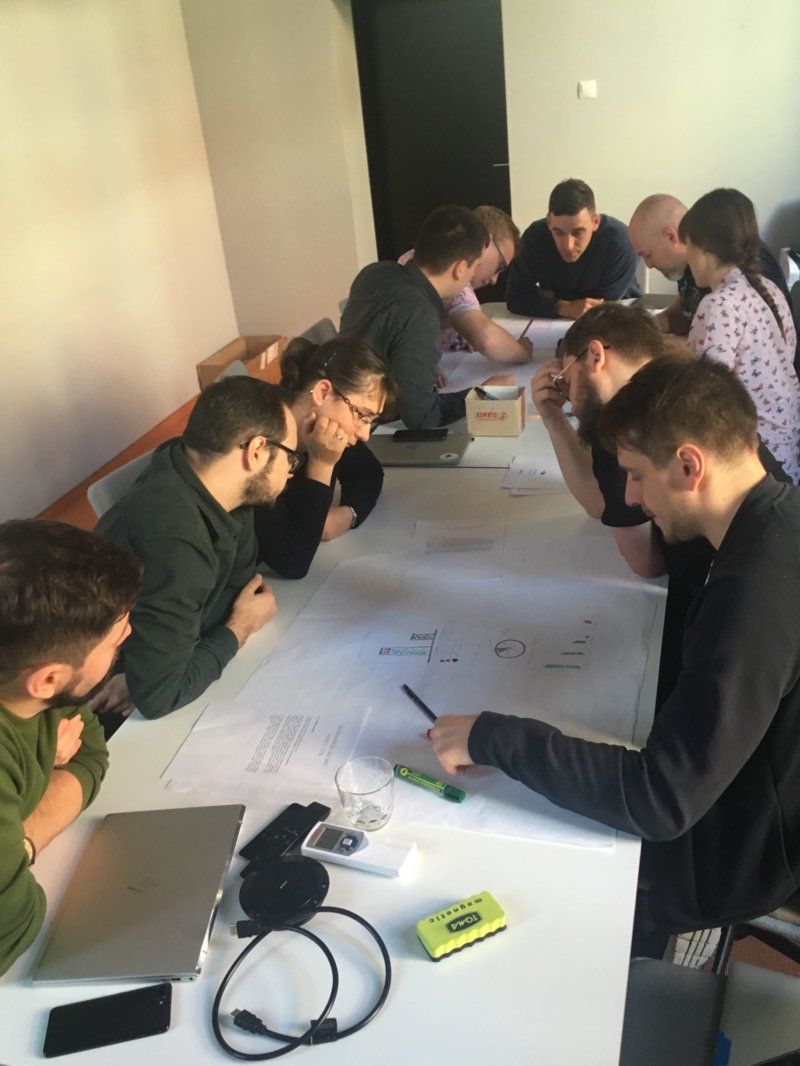07 July 2020
Training workshop for IT. I’ve done it before, so let me tell you how to organize a workshop for your team

How to design a workshop for your IT team so that knowledge is delivered in an attractive form, and of course, remembered for the future? Is it possible to organise training workshops remotely? You will learn the answers to all these questions after reading this article. Think of it as a kind of workshop on workshops. 😊 Let’s begin! 🎉
Today’s article is all about designing an IT training workshop. I am going to go over all of the aspects of organizing one, sharing some of my own experience from workshops made for The Software House.
💡 Making a workshop makes a difference
Hello! People call me Nusia, and I’m thrilled to share with you my experience in running a workshop. Why this particular topic? Each of us has a different background: received education, interests in particular books and other publications, participation in industry conferences, and so on. All this is to acquire new knowledge, improve skills and find solutions to everyday problems.
By transferring knowledge and sharing your experience, you not only teach yourself and others. You can really inspire and encourage someone to be actually interested in the topic and maybe pursue a career in that field.
There are many forms of passing knowledge, and one of them is the training workshop. Running a workshop requires a lot of preparation on the teacher’s part. The key to success is capturing and holding listeners’ attention, encouraging them to use knowledge in practice by active participation. 🙋♂ This method is also quite relevant while implementing new standards in your team or introducing new employees to the company.
💭 How to structure a training workshop?
You probably ask yourself, “where do I start?”. When the thought of a potential topic comes to your mind – write it down on a piece of paper. Think about the purpose of your training workshop and what its participants are supposed to achieve. Personally, I find the mind map technique really helpful.
In short, you can very easily organize information by writing down all the possible keywords related to the topic that you can think of. Eventually, you’ll be able to connect the dots and the whole structure of your training workshop will emerge.
I’ll show you how it works in my personal example. Recently, I’ve attended training in identifying risks in software projects. During the workshop, I realized that all the information I was receiving could be very helpful to my teammates as well. I decided to conduct a training workshop for them and use my newly acquired knowledge. My workshop goal for participants was to learn what risks may occur during our projects, what their sources and effects are, and how to prevent them from happening. I wrote down all my thoughts related to the topic, and not only have I trained my team but also written a blog post to pass this knowledge further.
BTW, I highly recommend you read it: IT project risk management: 7 most common software development risks. One of the ways to identify these risks is to organise a training workshop for your team.
If you just had an idea for a training workshop, that’s great! Make a quick note, and when reading the rest of the article, just add more elements that will match your idea.
Let’s say that you already know what you want to teach others, now it’s time to choose the form and prepare for the presentation.

💡 Read more: Building trust in a software team is a waste of time. Here’s what you should do instead
💁 Preparation of the trainer
⏳ Time
How long should your training take? It depends on how extensive the presented issue is. When determining the time, divide the training workshops into blocks and take into account a few breaks (lunch, smoking or just stretching one’s legs). Your workshops don’t have to last for several days. Sometimes an hour is enough for participants to learn the topic.
In my preparations, I assumed that the risk management training workshop would last around 60 minutes. However, a few days before the workshop started, I asked my colleagues to think about what risks occurred or may occur in projects they work on. That saved us some time on the training day and gave them more time to thoroughly prepare themselves.
📋 Organisation
Before sending a workshop invitation, set a date and prepare the agenda – it’s an outline of what you are going to talk about. If you conduct a training workshop for people from outside your company, it’s worth writing a few words about yourself and your qualifications. Remember to include a list of things participants will need during the training workshop, e.g. laptop, smartphone, application, properly configured environment, etc. The last thing is preparing the room and the things you will need – sticky notes, flipcharts, and sharpies. During the training workshop, it’s best to work in small groups of 10-15 people.
Organizing my first workshops wasn’t that difficult. After a short conversation with my work colleagues, I noticed they are interested so I set a date and booked the conference room. Then I was ready for the next stage…
👩💼 Presentation
A multimedia presentation is a great way to not get confused while conducting workshops, and not to forget any of the issues you want to raise. There are a lot of platforms that can help you: PowerPoint, Google Presentations, Prezi, Canva, Mentimeter, and many more. Take into account what’s the most important and show those elements on graphs or charts. We are accustomed to visual culture so images will remain in the memory for longer.
Hint for a personal experience. If you anticipate time for discussions or additional questions, you can include that on a separate slide after a given batch of material. The same goes for breaks. Between each thematic block put a slide with a coffee emoji on it, meaning – coffee break time!
📈 Techniques
When only the workshop leader talks throughout the training and the participants only “listen”, the information provided won’t be remembered. Therefore, it’s very important for the participants to be active, stimulated, and able to share their experiences. Here are a few tricks on how to achieve that.
- Questions create discussions
If you want to get some answers to your questions, put them in the presentation and specify the time for discussion. This is how team members get to know each other and learn how to talk to others respectfully and give courage to people who might be a bit shy. It’s best to start conversations in pairs, and then move to larger groups so that the participants feel comfortable.
- Fun games
There are many games that can be incorporated into your workshops. They stimulate the group, teach cooperation and encourage exchange of experiences. Here are some examples of games I use:
🗼 Building a block tower – the team’s task is to build a tower out of blocks in a given time. The task changes a bit during the construction. After completing the tower, the group needs to ask the questions: was the goal achieved, what were the roles in the team, how were they able to cooperate under changing conditions?
🧩 Set of puzzles to solve – may be logical, wooden, metal, e.g. seven-piece tangram.
🥔 Hot potato – the participant has only a few moments to come up with the answer to the question and throw the hot potato to the opponent. The goal is to get rid of the potato before time runs out. Otherwise, get burnt. You can use the Hot Potato app to measure time (yes, there’s an app for everything!).
⏱ 5 seconds – you need to prepare cards containing questions about your presentation. Participants take turns and have to answer their questions written on a piece of paper within 5 seconds. Of course, they can’t see the questions beforehand.
I’ve used those games during workshops with my QA team. I can assure you, there was a lot of laughter and the team was stimulated to continue working. And afterward, they all remembered important information because of all the funny situations that happened in between.
- Teamwork
Divide your participants into groups of 6-8 people. Firstly, you assign a task to each group and by brainstorming they have to find the best solution that everybody agrees on. When the time is up, the leader of the group presents the final result of their work. Then it’s discussion time between all groups and drawing general conclusions from the task.
Working in groups not only integrates. You can also observe the people’s behavior and their roles in the team: natural leader, analyst, creative, and so on.
During my workshops on project risk management, we started the meeting with the simple question – what is a risk? Every participant could provide their definition and then together we established one common definition that was applicable at our meeting. Then people were divided into two groups, each had to solve a set of puzzles. Every puzzle had its number of points. After an agreed time, we verified the results and identified the risks that the puzzles included according to the aforementioned definition.
Then we went on to list the risks in projects that occurred or may occur. During the brainstorming, we defined the effects and recovery plans for these risks. At the end of the meeting, we summarized the list of risks, which is now posted on the company’s Confluence and we use it in our projects.

💡 Read more: Technology gone wrong? Learn how to fix it with 5 digital transformation consulting scenarios
📔 Materials for participants
If possible, each participant should receive materials from the training at the beginning of the workshop. What could it be?
- Syllabus with theory, real-life examples, and sample tasks that appeared during the workshop
- Slides from the presentation that participants can supplement with their own notes during the training
- All materials that were created during the workshop: diagrams, post-it notes, photos of boards
Remember to be mindful of our planet! 🌎 If it’s not necessary to print on a paper, consider transferring materials in electronic form or using eco-solutions.
A well-prepared workshop is a satisfied participant. Therefore, when you prepare, you can put yourself in the role of participant and think about what you would expect from this particular workshop. You can check their expectations beforehand by sending a small task before the workshop along with the question of what they would like to learn the most. By analyzing the answers you will know how to reach the people during your workshop.
Training workshop planning template and scenario
When you are ready, the date of the workshop has been set and a group of participants has gathered, it’s time to start training.
You will spend some time together, so it is worth starting the meeting with the so-called icebreaker. It will allow participants to get to know each other a bit better and create a relaxed atmosphere.
Introduce yourself just like I did at the beginning of this article. I used the nickname Nusia for a reason – this is what my friends and work colleagues call me. It gives people I spend time with, e.g. during workshops, the feeling of closeness and trust. Tell a few sentences about yourself, what you do professionally, why you present a given topic, and what your hobbies are.
🤝 How to host a workshop – a proper introduction
Now it’s time for the participants to introduce themselves. Bear in mind that not everybody likes to talk about themselves in public unprompted. I have some techniques that will make it a bit more comfortable:
- Answers to a pre-prepared template: “My name is…”, “My role in the workplace is…”, “I chose this training because…”, “My expectations are…”.
- Speed dating: each participant talks to the other for a specified amount of time.
- Fact or fake: each person is asked to say three statements about themselves, two of which are true and one is false. The group’s task is to guess which is which by asking additional questions.
- Dixit cards: when you want to know the personality of a participant, you can use one of the popular Dixit games for this. Every person picks a card that suits them best and then explains why they chose that particular one.
- What’s your mood: each participant has two minutes to draw themselves or a person sitting opposite them. Then in one sentence, they describe the drawing. This is a very good method to start a workshop in a team where everybody knows each other and there’s no need for introductions.
The next step is to present the workshop’s agenda and goals. At this stage, some training leaders propose to establish internal, group regulations that will apply during the training (e.g. raising your hand if you want to ask a question, not interrupting when someone else speaks).
Sometimes you can also introduce the group roles, e.g. a person responsible for taking notes, minding the discussion time, or an observer who will present their comments at the end of the meeting.
Then it’s time for a well-deserved break. And when you come back…

🎯 Warm-up and energizing games
During long workshops, we all need a boost of energy to stay focused. Hence why a lot of trainers use stimulation games to wake people up. I gave you some examples earlier. However, my favorite back-to-work game is Associations. We start with a word related to the workshops – let’s say: “risk”. Then you throw a ball to one of the participants and ask for an association with the previous word. Then that person passes the ball further. It keeps people agile and focused because you never know when the ball is coming to you, so you need to listen to all associations, be prepared to catch and throw and come up with a new word. It’s simple, yet effective!
🧠 Running a workshop when participants are focused
Okay, we had a bit of fun, now it’s time for the theoretical part of the presentation. It should always be supported by practical examples. When discussing complicated issues, my advice is to use brainstorming. Participants can write their thoughts on sticky notes, create a mind map, discuss results with the group and finally select only the relevant elements.
Another method I use is a case study related to the training workshop’s topic. It’s always easier to explain and understand something based on a real example with real problems and solutions. During programming workshops, the best way to stimulate participants for a group effort is to modify a previously prepared application or create a new one from scratch without the faulty elements.
During any discussions, write relevant elements that confirm the discussed theory on the board. It will help participants to memorise the most important information better.
If you see that the group is no longer active, you can do one of the following things:
- suggest taking a break,
- introduce a short game to give the energy boost,
- encourage the group to change their position (e.g. get up and stick notes to the wall).
📍 You’ve exhausted the topic and it’s time to wrap up
The most important element of the summary is evaluation. Ask a question about whether everybody feels like the workshop goals have been achieved. Introduce a brief discussion of the most important things and encourage people to use the newly acquired knowledge in practice.
At the very end of the training workshop, it is worth getting to know the participants’ opinions. Use a brief survey – are the participants happy with the training, are they satisfied with new knowledge, what they liked and what was unnecessary, were their expectations met, and so on. You can use that feedback for future improvement of your workshops.
💡 Read more: Software tester against the world. Managing team conflict in Agile projects
How to organize a workshop remotely?
Recently, we’ve been put in an unprecedented situation and meeting face-to-face is impossible. So is it possible to plan a workshop remotely? Of course!
The global pandemic resulted in the massive popularity of online webinars where participants can communicate with the trainer in real time. Using virtual tools like Zoom or Jamboard, users can listen to the speaker, follow the multimedia presentation and ask questions on chat.
Obviously, you might not be able to use some of the aforementioned methods during an online meeting but using practical examples is still possible. Participants can work on them individually and then share their results with the group. For example, a brainstorming session can be conducted in the chat window.
Is it worth participating in online webinars? One hundred times yes! You can connect with people from all over the world and expand your knowledge together.
You can check out online webinars organized by The Software House on our YouTube channel. Make sure to follow us on Facebook, Twitter, or LinkedIn for information on new workshops. I can assure you, we organize them regularly with hundreds of participants on board. Join us!

